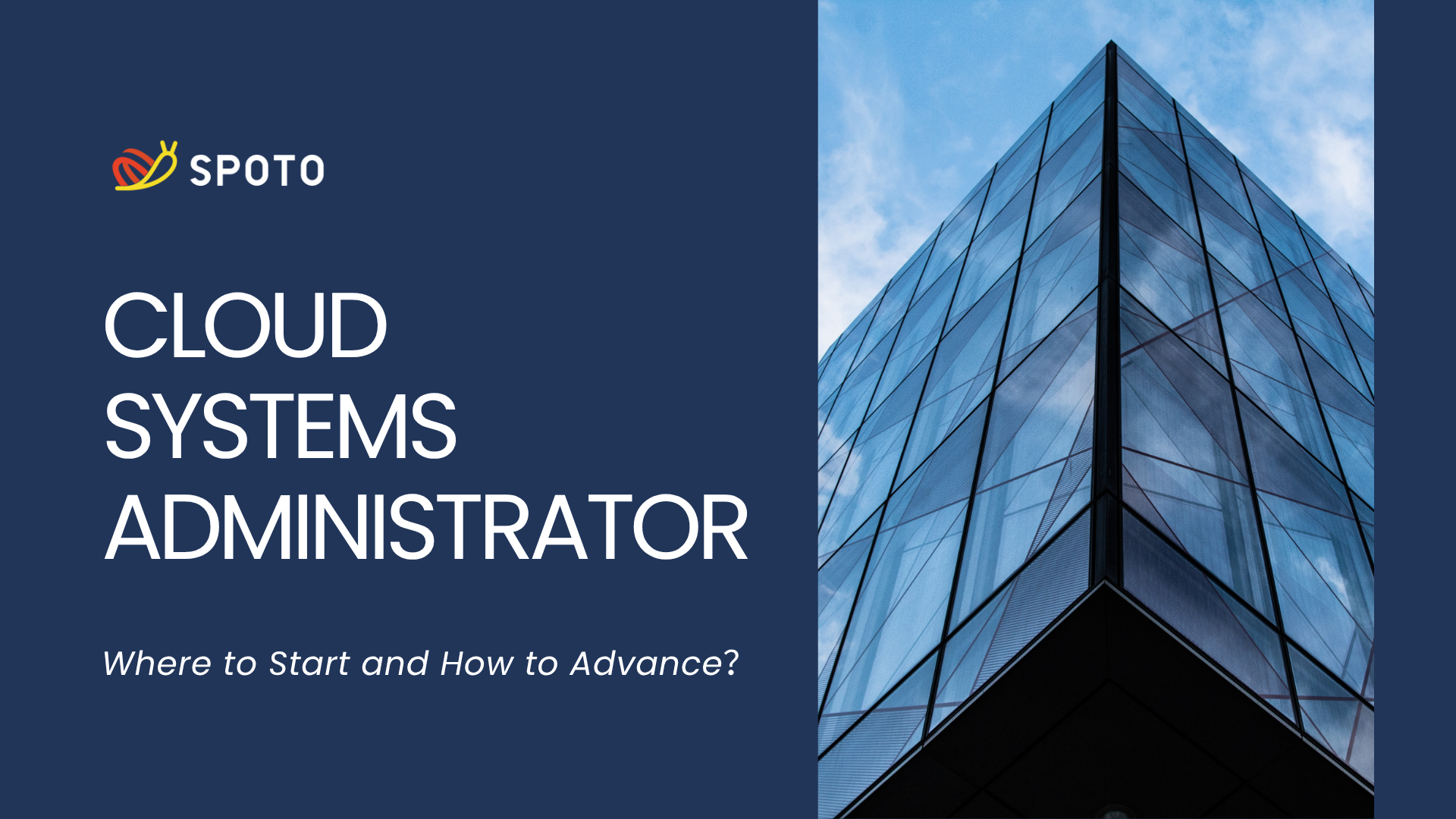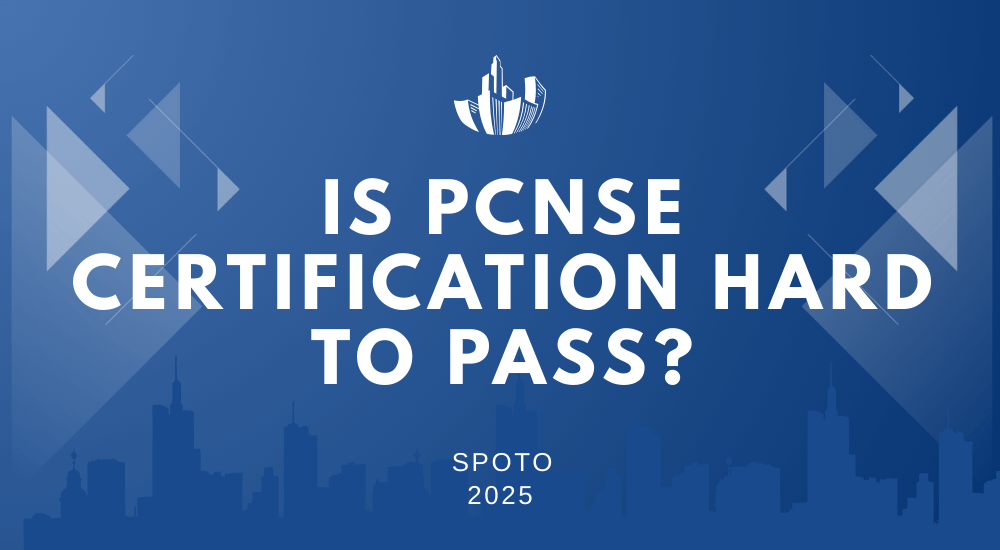TRUSTED BY THE SMARTEST TEAMS IN THE WORLD FOR CERTIFIED CANDIDATES
SPOTO Blogs
Useful learning materials to become certified IT personnel
-
- 766
- Emma
- 2025-05-13 16:23
-
- 1127
- Emma
- 2025-05-13 15:31
-
- 823
- Emma
- 2025-05-12 16:44
-
- 542
- SPOTO
- 2025-04-29 13:38
-
- 655
- SPOTO
- 2025-04-18 15:22
-
- 1525
- SPOTO
- 2025-04-08 15:00
-
- 851
- circle
- 2025-04-08 11:27
-
- 1103
- circle
- 2025-04-07 11:48
-
- 1362
- circle
- 2025-03-31 11:58
TRUSTED BY THE SMARTEST TEAMS IN THE WORLD FOR CERTIFIED CANDIDATES
SPOTO Blogs
Useful learning materials to become certified IT personnel
-
- 766
- Emma
- 2025-05-13 16:23
Table of Contents1. What is a cloud systems administrator?2. How to Become a Cloud Systems Administrator?3. The Details4. Conclusion In the ever-evolving landscape of technology, cloud computing has taken center stage. Cloud systems administrators are the unsung heroes behind the scenes, ensuring that cloud-based systems operate smoothly, securely, and efficiently. If you're intrigued by the world of cloud technology and considering a career as a cloud systems administrator, this blog is your guide. 1. What is a cloud systems administrator? A cloud systems administrator is a professional responsible for managing and maintaining an organization's cloud-based infrastructure. Think of them as the architects and caretakers of a digital city in the cloud. They handle a wide range of tasks to keep the cloud environment running like a well-oiled machine. Job Duties: Cloud Infrastructure Provisioning: Cloud Systems Administrators are in charge of setting up new cloud resources. This involves creating virtual machines, storage volumes, and networking components on cloud platforms such as Amazon Web Services, Microsoft Azure, or Google Cloud Platform. System Monitoring and Maintenance: They continuously monitor the performance of cloud-based systems. If any issues arise, such as a sudden spike in error rates, the administrator takes prompt action to resolve them. This could include scaling resources up or down, patching software, or troubleshooting network problems. Security and Compliance: Ensuring the security of cloud systems is a top priority. Cloud systems administrators implement security measures like access controls and intrusion detection systems. They also make sure that the cloud infrastructure complies with industry regulations and internal company policies. Disaster Recovery and Business Continuity: Planning for the worst-case scenario is part of the job. Cloud systems administrators develop and test disaster recovery plans to ensure that in the event of a major outage or data loss, the organization can quickly recover its cloud-based services. They may set up backup systems in different geographical regions and perform regular recovery drills to verify the effectiveness of these plans. 2. How to Become a Cloud Systems Administrator? Education and Training A bachelor's degree in computer science, information technology, or a related field is often a good starting point. These programs provide a solid foundation in computer systems, networking, and programming. However, many successful cloud systems administrators also come from diverse educational backgrounds and have gained relevant skills through self-study and online courses. Gain Technical Skills Cloud Platform Proficiency: Mastering at least one major cloud platform is essential. Start with the basics of creating and managing resources on platforms like AWS, Azure, or Google Cloud. Get Certified CompTIA A+, CompTIA Network+, and CompTIA Cloud+ certifications can help you become a cloud systems administrator. Earning these certifications demonstrates your fundamental understanding of cloud systems administration across different providers. Gain Practical Experience Internships and Entry-Level Jobs: Look for internships or entry-level positions in companies that use cloud technology. This hands-on experience will allow you to apply your theoretical knowledge in a real-world setting. You'll get to work on actual cloud systems, learn from experienced administrators, and gain insights into the day-to-day challenges of the role. 3. The Details Cloud Systems Administrator Salary Range The salary of a cloud systems administrator can vary depending on factors such as experience, location, and certifications. On average, in the United States, entry-level cloud systems administrators can expect to earn around $73,000 per year. With a few years of experience and relevant certifications, this figure can easily exceed $100,000. Cloud Systems Administrator Job Outlook The job outlook for cloud systems administrators is extremely promising. As more and more companies are migrating their operations to the cloud, the demand for skilled administrators is skyrocketing. According to industry reports, the field of cloud computing is expected to grow at a rapid pace in the coming years. This growth is driven by factors such as cost-efficiency, scalability, and the need for businesses to stay competitive in the digital age. Cloud systems administrators will be in high demand to manage and optimize these cloud-based systems, ensuring job security and plenty of opportunities for career advancement. Related Jobs: Cloud Architect DevOps Engineer System Administrator Network Administrator Cloud Security Engineer Cloud Integration Specialist 4. Conclusion Embarking on a career as a cloud systems administrator is an exciting journey filled with opportunities for growth, learning, and high-impact work. By understanding the role, acquiring the necessary skills, and staying updated with the latest trends in cloud computing, you can position yourself for success in this dynamic field. Whether you're just starting out or looking to advance your career, the cloud systems administration path offers a rewarding and fulfilling career trajectory in the ever-expanding world of technology. Will your next move be cloud systems administrator? If so, check out CompTIA Cloud+ to get the skills to get you there. -
- 1127
- Emma
- 2025-05-13 15:31
Table of Contents1. What is a cloud support engineer?2. What does a cloud support engineer do?3. Why become a cloud support engineer?4. How to Become a Cloud Support Engineer? In the ever-expanding digital universe, cloud computing has emerged as a dominant force. As more and more businesses migrate their operations to the cloud, the role of a cloud support engineer has become not just important, but essential. Let's explore what this role entails, why it's a great career choice, and how you can embark on this rewarding journey. 1. What is a cloud support engineer? A cloud support engineer is a professional who serves as the front-line troubleshooter and problem-solver for cloud-based services. They are the ones ensuring that cloud-computing environments run smoothly, efficiently, and securely for businesses of all sizes. Whether it's a small startup relying on cloud-hosted software or a large enterprise with a complex multi-cloud infrastructure, cloud support engineers are the key to maintaining seamless operations. Related Occupations: Cloud Administrator Cloud Architect Cloud Security Engineer DevOps Engineer (with a focus on cloud-related support and operations) 2. What does a cloud support engineer do? Monitoring and Incident Detection Cloud support engineers use specialized monitoring tools to keep a close eye on cloud-based systems. They watch for any signs of performance degradation, outages, or security threats. For example, they might notice unusual spikes in server resource usage or a sudden increase in error rates for a cloud-hosted application. Troubleshooting and Problem Resolution When problems do occur, cloud support engineers jump into action. They analyze error messages, system logs, and performance data to identify the root cause of the issue. Once they've pinpointed the problem, they implement solutions, whether it's adjusting a server configuration, updating software, or coordinating with other teams to resolve more complex issues. Customer Support and Communication They are often the main point of contact for customers experiencing issues with cloud services. Cloud support engineers need to communicate clearly and effectively with customers, both technical and non-technical. They explain complex technical problems in simple terms and keep customers informed about the progress of issue resolution. Collaboration with Cross-Functional Teams Cloud support engineers don't work in isolation. They collaborate closely with other teams such as development, operations, and security. In a situation where a new feature deployment in a cloud-based application causes performance issues, the cloud support engineer will work with the development team to identify the source of the problem and with the operations team to implement a fix while minimizing downtime. 3. Why become a cloud support engineer? Abundant Job Opportunities and Stable Employment Companies across industries are migrating to the cloud, creating a huge demand for cloud support engineers. This high demand means job security, as organizations are constantly on the lookout for skilled professionals to keep their cloud-based operations running smoothly. Challenging and Intellectually Rewarding Work Cloud computing is a dynamic field with new technologies and challenges emerging regularly. As a cloud support engineer, you'll be constantly learning and solving complex problems. For example, with the rise of serverless computing and edge computing in the cloud, you'll have the opportunity to explore and master these new technologies and find ways to support and optimize them. Each day brings a new set of issues to solve, keeping your mind engaged and your skills sharp. Making a Significant Impact in the Digital Realm Cloud support engineers play a vital role in ensuring the success of businesses in the digital age. By keeping cloud-based services up and running, they enable companies to focus on their core operations. Their work also contributes to the overall stability and security of the digital ecosystem. Diverse Career Progression Avenues The skills and experience gained as a cloud support engineer can open the door to a variety of related career paths. You can specialize in areas such as cloud security, where you focus on protecting cloud-based data and applications. Or you could move into a cloud architect role, where you design and plan complex cloud-based systems. There are also opportunities to work in different industries, allowing for a diverse and fulfilling career. 4. How to Become a Cloud Support Engineer? Obtain a Relevant Degree A bachelor's degree in computer science, information technology, or a related field is often a good starting point. These programs cover fundamental topics such as programming, networking, and operating systems, which are essential for understanding cloud computing. Gain Technical Skills Dive deep into major cloud platforms. Sign up for free trials or use educational resources provided by cloud providers like AWS Educate, Microsoft Learn for Azure, and Google Cloud Training. Practice creating virtual machines, setting up storage buckets, and configuring network security groups. Get Certified CompTIA Cloud+ is a great vendor-neutral certification. It covers a broad range of cloud computing concepts, including cloud infrastructure, security, and operations, providing a solid foundation for your career as a cloud support engineer. Gain Practical Experience Look for internships with companies that use cloud services. This hands-on experience will allow you to apply your theoretical knowledge in a real-world setting. You'll get to work on actual cloud-support tasks, learn from experienced engineers, and gain valuable insights into the day-to-day operations of a cloud-support team. Stay Updated The cloud computing field is constantly evolving. Subscribe to industry blogs like The Cloud Security Alliance Blog, follow cloud-computing experts on social media platforms like Twitter, and join professional organizations such as the Cloud Native Computing Foundation. -
- 823
- Emma
- 2025-05-12 16:44
Table of Contents1. What is Cybersecurity Analyst?2. What does a cybersecurity analyst do?3. Why become a cybersecurity analyst?4. How to Become a Cybersecurity Analyst? In today's highly digitalized era, cybersecurity analysts have become the indispensable defensive core for enterprises. With increasingly sophisticated cyber threats, these professionals not only monitor network anomalies in real-time but also proactively build defense systems and predict potential risks. 1. What is Cybersecurity Analyst? A cybersecurity analyst is a professional responsible for protecting an organization's digital assets from various cyber threats. The demand for cybersecurity analysts is high and continues to grow as organizations increasingly recognize the importance of protecting their digital assets. Related Occupations: Incident Response Analyst Security Architect Cybersecurity Engineer Vulnerability Analyst Security Operations Center Analyst Application Security Analyst 2. What does a cybersecurity analyst do? Job Responsibilities Threat Monitoring and Detection: Use various security tools and technologies to continuously monitor the organization's network, systems, and applications. Vulnerability Assessment and Management: Regularly assess the security vulnerabilities of the organization's IT infrastructure. Incident Response: When a security incident occurs, the cybersecurity analyst needs to quickly contain the incident, investigate its root cause, and work with other teams to mitigate the impact and prevent similar incidents from happening again. Security Policy and Procedure Development: Assist in the development and implementation of security policies and procedures. Ensure that these policies are in line with industry best practices and regulatory requirements. Security Awareness Training: Educate employees within the organization about cybersecurity best practices. Required Skills Technical Skills: Proficiency in network security technologies, such as firewalls, intrusion detection systems, and virtual private networks (VPNs). Knowledge of operating systems, programming languages, and database management is also essential. Analytical Skills: Ability to analyze complex security data and identify trends, patterns, and potential threats. Strong problem-solving skills are needed to address security issues effectively. Communication Skills: Good communication skills are required to report security incidents and findings to both technical and non-technical stakeholders. Knowledge of Security Frameworks and Standards: Familiarity with industry-recognized security frameworks and standards. 3. Why become a cybersecurity analyst? Becoming a cybersecurity analyst offers a multitude of advantages, including high demand in the job market, the opportunity to work with cutting-edge technology, and the ability to make a significant impact on an organization's security. Here are the details: High Demand and Job Security Organizations across all industries rely on cybersecurity analysts to protect their sensitive information, financial assets, and reputation. This high demand ensures a stable job market with excellent career prospects. Intellectually Stimulating Work The field of cybersecurity is dynamic and challenging, requiring analysts to constantly stay updated on the latest threats, technologies, and security trends. Cybersecurity analysts are constantly solving complex problems, analyzing data to detect and prevent cyberattacks, and devising innovative strategies to safeguard digital assets. Lucrative Salary and Benefits Due to the high demand and specialized skills required, cybersecurity analysts enjoy competitive salaries. According to Payscale, the average salary for a cybersecurity analyst in the United States is around $84,000 per year, with the potential to earn even more with experience and additional certifications. In addition to a good base salary, many positions also come with benefits such as health insurance, retirement plans, and bonuses. Opportunity to Make a Difference Cybersecurity analysts play a crucial role in protecting organizations, governments, and individuals from the devastating consequences of cyberattacks. By preventing data breaches, they safeguard the personal information of customers, protect the financial stability of companies, and contribute to the overall security and stability of the digital ecosystem. Their work helps maintain the trust and confidence of the public in the online world, which is essential for the continued growth and success of the digital economy. Diverse Career Paths The skills and experience gained as a cybersecurity analyst can open the door to a variety of related career paths. Analysts can specialize in areas such as network security, application security, cloud security, or incident response. Additionally, there are opportunities to work in different industries, including finance, healthcare, government, and technology, allowing for a diverse and fulfilling career. 4. How to Become a Cybersecurity Analyst? Obtain a Relevant Degree A bachelor's degree in cybersecurity, information technology, computer science, or a related field is often the minimum requirement. These programs cover essential topics such as network security, operating systems, programming, and database management. Gain Technical Skills Network Security: Learn about firewalls, intrusion detection and prevention systems, VPNs, and network protocols to secure network infrastructure. Operating Systems: Have a good understanding of Windows and Linux systems, including security configurations and patch management. Get Certified CompTIA Security+: This is an entry-level certification that validates basic knowledge and skills in network security, compliance, and operational security. It's a good starting point for those new to the field. CompTIA Cybersecurity Analyst (CySA+): It is a certification for network professionals. It is more in-depth and focuses on practical network security analysis and detection work compared to CompTIA Security+. Gain Practical Experience Internships: This hands-on experience will give you a chance to apply your classroom knowledge in a real-world setting and learn from experienced professionals. Personal Projects: Work on personal cybersecurity projects, such as setting up a home lab to practice network security configurations and creating a simple web application and testing it for security vulnerabilities. Stay Updated The field of cybersecurity is constantly evolving, with new threats and technologies emerging regularly. Subscribe to industry publications, follow cybersecurity blogs and podcasts, and join professional organizations such as ISSA. Attend conferences, webinars, and training sessions to stay current with the latest trends and best practices. -
- 542
- SPOTO
- 2025-04-29 13:38
Table of Contents1. What is a Solutions Architect?2. What does a Solutions Architect do?3. Career Insights: Salary, Outlook & Related Roles4. How to Become a Solutions Architect? 1. What is a Solutions Architect? Solution Architects design, describe, oversee and manage technical solutions to organizational business problems and ensure the implementation of complex technical solutions to address business challenges or needs. These professionals bridge the gap between business needs and technical capabilities by translating business requirements into technical specifications and designing comprehensive solutions that meet organizational goals. 2. What does a Solutions Architect do? Solution architects play a variety of important roles in different organizations and projects, and are responsible for connecting business needs with technical implementation. Their main work includes: Requirements collection and analysis: Work closely with stakeholders such as business leaders, project managers and end users to collect and deeply analyze business needs, understand organizational goals, challenges and technical requirements, and convert them into clear technical specifications and architectural designs. Technical solution design: Based on business needs, design a comprehensive technical architecture solution, including system structure diagrams, component divisions and integration point descriptions. Select appropriate technologies, platforms and architectural models to ensure that the solution meets functional and non-functional requirements such as performance, security and scalability. Technical leadership and collaboration: Provide technical guidance throughout the project life cycle, work with development teams, system administrators and other IT professionals to ensure that the project strictly follows the established architectural design and best practices. At the same time, guide junior architects, provide professional technical support, and assist in decision-making and problem solving. Risk assessment and optimization: Actively evaluate the potential risks and limitations of the solution, and make improvement suggestions for key factors such as scalability, performance, security and compliance, effectively reduce project risks, and ensure the long-term stable operation of the system. Cross-departmental communication and coordination: As an important bridge between the business team and the technical team, we can convey complex technical concepts in clear and understandable language. Through solution presentation, opinion collection and feedback integration, we ensure that the architecture design fully responds to business needs and is continuously optimized. 3. Career Insights: Salary, Outlook & Related Roles (1) Solutions Architect Salary The U.S. Bureau of Labor Statistics (BLS) reports that the median annual wage for solutions architects will be $129,840 in 2023. Computer network architects working in corporations, business administration, or the telecommunications industry earn the highest salaries. Professional experience, certifications and degrees, and the local job market can affect salary ranges. (2) Job Outlook of Solutions Architect The job outlook for solutions architects is very positive, with employment projected to grow 13% between 2023 and 2033, faster than the average for all occupations. According to the U.S. Bureau of Labor Statistics, employment of solutions architects (also known as computer network architects) is projected to grow 13% between 2023 and 2033. As companies continue to expand their digital capabilities and information technology (IT) networks, steady job demand is likely. (3) Similar Occupations Software Engineer Cloud Engineer Systems Engineer Technical Consultant Enterprise Architect Chief Technology Officer (CTO) Software Engineering Manager Systems Analyst Network Engineer Cloud Architect Data Architect 4. How to Become a Solutions Architect? (1) Obtain a Bachelor's Degree The first step to becoming a solutions architect is to earn a bachelor's degree in a related field, such as computer science, information technology, engineering, or a related discipline. Courses in software development, network programming, database management, and organizational management can provide a solid foundation for a solutions architect's career. (2) Develop professional skills When recruiting for this position, companies tend to recruit candidates with many years of experience in software development, system engineering or IT consulting. This is because candidates need to have a deep understanding of various technologies, platforms and architectural models in order to design and implement effective solutions. This requires candidates to develop technical skills in software development, cloud computing, networking, database management and system integration, and continue to pay attention to emerging technologies and industry trends. (3) Earn Industry Certifications While not always required, earning an industry-recognized certification can demonstrate your expertise and enhance your credentials and credibility as a solutions architect. Cisco Certified Design Expert (CCDE) certification.The Cisco Certified Design Expert (CCDE) certification shows the world that you have what it takes to be an elite designer of IT solutions. The CCDE certification program will equip you with the broad knowledge and skills to tackle complex IT projects, including network architecture and design. (4) Gain experience in solution design and implementation Seek to work on projects that design and implement technology solutions for an organization. Work with stakeholders to gather requirements, develop architectural designs, and oversee the implementation of solutions, demonstrating your ability to deliver results that meet business needs. -
- 655
- SPOTO
- 2025-04-18 15:22
Table of Contents1.What Is a Network Designer?2.Professional Skills Needed to Become a Network Designer.3.The Details4.What Education is Required to Become a Network Designer?5.Becoming Certified as a Network Designer In today's interconnected world, the backbone of every organization is its network infrastructure. At the heart of this infrastructure are Network Designers—professionals who meticulously plan, design, and implement the systems that enable seamless communication and data flow. Their expertise ensures that networks are not only functional but also secure, scalable, and aligned with the organization's strategic goals. Network Designers collaborate closely with IT teams to create customized solutions that meet specific business needs. They analyze existing systems, anticipate future requirements, and integrate new technologies to enhance performance and reliability. Their role extends beyond mere technical implementation; they are visionaries who anticipate challenges and design networks that can adapt to evolving demands. This article offers a professional and authoritative look at what a Network Designer is, how to pursue this career path, and practical steps you can take to get there. 1.What Is a Network Designer? A Network Designer plays a key role in building the digital backbone of an organization. They are responsible for designing, developing, and maintaining tailored computer networks that enable secure, efficient communication and data sharing across teams and systems. By understanding business goals, they create cost-effective network solutions that support current operations and future growth. In addition to planning the network architecture, Network Designers may also provide technical support, troubleshoot connectivity issues, and ensure the system aligns with both performance needs and security standards. Their work helps keep organizations connected, productive, and prepared for evolving technological demands. Key Responsibilities of a Network Designer Design, implement, and manage tailored computer networks and systems to meet specific organizational needs Evaluate current network infrastructures and assess emerging technologies for integration and improvement Install and maintain key network components, including LANs, WANs, intranets, and other data communication systems Perform network security assessments and deploy protective measures such as firewalls and security protocols Identify and resolve technical issues affecting network performance and connectivity Lead and oversee a team of network engineers to ensure efficient project execution Enhance and modernize existing network infrastructure to support scalability and performance 2.Professional Skills Needed to Become a Network Designer. Solid Understanding of Networking Basics Mastery of essential networking elements—like IP structures, routing, and protocols—is key to building functional and reliable networks. Strategic Network Design Skills The ability to craft structured, scalable, and efficient network frameworks that meet both current demands and future growth. Strong Focus on Network Security Proficiency in applying security measures such as firewalls, authentication systems, and data encryption to safeguard digital assets. Performance Monitoring and Optimization Experience in assessing network performance, identifying inefficiencies, and implementing upgrades to improve overall functionality. Effective Communication and Teamwork Strong interpersonal skills to collaborate with cross-functional teams, gather requirements, and explain complex concepts clearly. Adaptability and Analytical Thinking A mindset geared toward continuous learning, along with the ability to troubleshoot problems and adapt designs to evolving technologies. 3.The Details How much does a Network Designer make? According to the latest data from ZipRecruiter, the average hourly wage for a Network Designer in the United States is $47.24 as of April 10, 2025. Hourly rates across the country typically range from $24.28 to $61.54. The 25th percentile earns approximately $39.42 per hour, while the 75th percentile earns around $57.69 per hour. This wide pay range—nearly $18—indicates significant variation based on factors such as skill level, geographic location, and years of experience, as well as potential opportunities for career advancement and higher compensation. Career Outlook for Network Designers The career outlook for Network Designers, also known as Computer Network Architects, is highly promising. Employment in this field is projected to grow by 13% from 2023 to 2033, which is much faster than the average for all occupations. This growth is primarily driven by the increasing reliance on computer networks and the heightened need for businesses to safeguard their systems against cyber threats. Although the U.S. Bureau of Labor Statistics (BLS) does not provide specific data for "Network Designers," related roles such as computer network architects indicate a strong demand for skilled professionals in network design. As businesses across various industries continue to prioritize secure and advanced network infrastructures, the demand for Network Designers is expected to remain robust in the coming years. Job Titles Related to Network Designer Solutions Architect Network Architect Network Systems Administrator Network Specialist NOC Technician NOC Engineer Network Systems Engineer Network Analyst Cloud Network Engineer Network Software Engineer Network Infrastructure Engineer Principal Network Engineer 4.What Education is Required to Become a Network Designer? (1)a bachelor's degree in computer science, IT or a related field. To pursue a career as a network designer, also known as a computer network architect, candidates typically need to meet specific educational requirements. According to authoritative sources, a bachelor's degree in a related field is generally required. Relevant fields of study include:​ Computer Science Information Technology Network Engineering Computer Engineering Information Systems Software Engineering​ These degree programs typically encompass courses in mathematics, systems engineering, software design, information systems development, statistics, programming languages, and operating systems. The curriculum is designed to provide a comprehensive understanding of the technical and theoretical aspects essential for designing and managing complex network infrastructures.​ While a bachelor's degree is the standard educational requirement, some positions may also value advanced certifications or a master's degree in a specialized area, such as network security or cloud computing, to enhance career prospects and expertise.​ (2)Related professional certification Certifications are highly valued by many employers as they demonstrate your specialized skills and expertise. Obtaining a relevant certification not only highlights your unique qualifications but also sets you apart from other candidates. Additionally, some tech companies and manufacturers offer certification programs specific to their equipment, further enhancing your marketability.Among them, CCDE can provide a good boost to your career as a network designer and enhance your workplace competitiveness. Cisco Certified Design Expert (CCDE) This certification provides a comprehensive understanding of network architecture and design.It equips professionals with the essential knowledge and skills needed to manage complex IT projects.The focus is on mastering the intricacies of network systems and their design, preparing candidates for advanced roles in IT. 5.Becoming Certified as a Network Designer Designing a truly transformative IT solution requires more than just technical know-how. The CCDE certification program equips you with the comprehensive skills and knowledge needed to tackle complex IT projects in network architecture and design. To obtain this certification, you only need to pass two exams: A written exam A practical exam, including core topics and an elective of your choice However, you will gain: Designing for a comprehensive solution Business and engineering teams requirements analysis Technology analysis Rework and analyze existing networks -
- 1525
- SPOTO
- 2025-04-08 15:00
Table of ContentsNew! Cisco Wireless CertificationsLatest News: Huawei Certification OnVUE online proctoring service will no longer be availableLatest News: Cisco Certification Updates – "A New Era for Cisco Certifications"Latest News: Fortinet Certification Updates – NSE Program (Effective October 15, 2025)Latest News: Job OpeningsLatest News: PMBOK 8th Edition reviewTips: If you want to get certified fast, ping me for more details!IMPORTANT UPDATE: CompTIA A+ Exam ChangesIMPORTANT UPDATE: PMP Exam Fee Changes New! Cisco Wireless Certifications Cisco is introducing a new wireless certification track, reestablishing a dedicated focus on modern wireless technologies. The track includes Professional and Expert-level certifications that build practical skills to design, deploy, and manage advanced wireless networks. The new CCNP Wireless exams realign wireless content previously found in CCNP Enterprise, while the CCIE Wireless practical exam now incorporates Cisco Meraki along with Wi-Fi 6 and Wi-Fi 7. On March 19, 2026, Cisco will launch a Wireless certification track, the CCNP Wireless certification, and the CCIE Wireless certification. Key updates taking effect March 19, 2026: Wireless topics currently covered in the CCNP Enterprise Core (ENCOR) exam will be incorporated into a new exam: Implementing and Operating Cisco Wireless Core Technologies (350-101 WLCOR) v1.0. The following CCNP Enterprise exams will be realigned and renamed to the CCNP Wireless certification: CCNP Enterprise Last date to test March 18, 2026 CCNP Wireless Effective March 19, 2026 Designing Cisco Enterprise Wireless Networks v1.1 (ENWLSD 300-425) Designing Cisco Wireless Networks v1.2 (WLSD 300-110) Implementing Cisco Enterprise Wireless Networks v1.1 (ENWLSI 300-430) Implementing Cisco Wireless Advanced Solutions v1.2 (WLSI 300-120) Candidates that have passed 300-425 ENWLSD and 300-430 ENWLSI exams within the past 3 years, can choose to take the new 350-101 WLCOR exam to achieve CCNP Wireless certification Latest News: Huawei Certification OnVUE online proctoring service will no longer be available Starting from September 16 (Beijing Time), the Huawei Certification OnVUE online proctoring service will no longer be available to overseas individual candidates. Overseas TO B customers and partners who need to take the OnVUE online exam must have their local representative/regional contact organize and apply on their behalf. Huawei will continue to offer VUE on-site exam services. All candidates can book VUE on-site exams through the original booking channels. Latest News: Cisco Certification Updates – "A New Era for Cisco Certifications" Cisco is refreshing its certification framework to emphasize automation, software application design, and development skills. Specifically: Three revamped certification tracks have been introduced, targeting core competencies in network automation, application design, and software development. These appear to focus on aligning traditional networking credentials—like CCNA, and CCNP tracks—with modern, software-centric demands. Among these updates is the evolution of DevNet, which suggests a strong shift toward developer-focused skills across Cisco's certifications. Changes will take effect on February 3 (year unspecified in the summary, but presumably aligned with Cisco's roadmap updates). Although Cisco's summary doesn't list each updated certification by name, it's clear that: DevNet certifications are being elevated. CCNA and CCNP (e.g., Enterprise, Collaboration, Cybersecurity) tracks are being restructured to integrate more automation and development-related content. For more details, visit: Cisco: A New Era for Cisco Certifications Latest News: Fortinet Certification Updates – NSE Program (Effective October 15, 2025) Fortinet is rolling out substantial enhancements to its NSE (Network Security Expert) Certification Program: Reintroducing NSE Levels 1–8 as formal progress-based tracks. Adjusting certification tracks, which likely reflects the retirement of some offerings and a restructured curriculum flow. Retirement of the FCSS Zero Trust Access certification on June 30, 2025. The content has been redistributed into other FCSS paths, and current certifications remain valid until they expire. For those focused on ZTNA with FortiGate only, the recommended path is: FCP in Network Security → FCSS in Network Security For those combining ZTNA with FortiGate and FortiSASE, the path becomes: FCP in Network Security → FCSS in Secure Access Service Edge Latest News: Job Openings 崗位1:IT維運職位 詳情 負責超市門市建置專案IT基礎設施相關工作(包括不限於網路方案建置, 設備調試, 無線調配等)落地實施; 負責超市門市PC設備的系統安裝,軟體安裝,相關問題的排除; 負責超市門市POS,生鮮秤,掃描槍,PDA,電子價簽等職能終端設備的安裝、配置、問題排錯; 負責超市門市IT機房設備(防火牆,交換機,伺服器等)的日常管理與維護; 負責日常監控門市接取網絡,區域網絡,WIFI網路運作狀態(透過zabbix, ELK日誌系統等工具),快速解決相關網路問題; 協助超市門市智慧業務系統(電子秤, 電子價簽等管理系統)的部署、管理、維護工作; 協助業務處理其他IT相關問題,助理業務的穩定營運與發展 要求 本科以上學歷,熟悉辦公室或連鎖店網路基礎建設,有獨立IT專案建設經驗優先: 熟悉市面主流網路設備(如華為,H3C,銳捷等)交換器、防火牆、無線等網路系統概念及配置,具備網路故障分析排障能力; 精通Windows桌面作業系統及常用辦公室軟體; 有線下零售IT維運經驗者優先: 熟悉新零售業態的各種智慧終端如POS,電子價簽,電子秤等設備的使用與維護; 熟悉 linux centos系統, 會部署常見應用程式, 如kvm, ngix服務等, 有雲端操作經驗或維運自動化開發經驗優先; 具備鑽研精神及獨立解決問題的能力,較好的溝通總結能力,能接受在新零售業發展;有較強抗壓能力, 良好的服務意識; 可接受國內短期出差 地點在京津冀 京東職缺 目前招聘職缺是P5 具體薪資自己談,市面P5薪資基本15K左右 崗位2:ICT SE售前經理(P3A-P4A) 崗位職責: 工作地點:香港 負責客戶需求溝通,技術交流,方案設計,配置澄清與報價等售前支援工作。 組織策劃並負責公司產品的區域訓戰、行銷支援、話術賦能等產品拓展工作; 具備較強的ICT能力,能夠獨自設計產業性綜合方案(網絡,安全,虛擬化,雲端);有較強的技術實施能力,能夠對產業常規產品可以直接上手配置。 了解產業動態及產業發展方向,具備市場資訊收集及競爭對手狀況分析。 任職資格 教育背景:全日製本科及以上學歷,電腦科學、資訊科技、工程管理或相關專業。 工作經驗:至少3-5年ICT專案經驗,有成功落地複雜ICT專案的經驗者佳。 技能要求: 專業資質,擁有CCIE,HCIE,CISSP,等優先。 精通網路技術、儲存技術、精通雲端、大數據、通訊、安全、物聯網應用等某一領域相關技術 具有良好的團隊意識,執行力強,抗壓性強。能適應多項目同時處理的工作要求 良好的成本和預算管理知識,能夠進行專案成本估算和控制,具有出色的成本意識和風險意識。 國語,英語,粵語流利,具備良好的書面和口頭表達能力。 待遇 年包五十萬起步,能力強可以聊。 Latest News: PMBOK 8th Edition review The PMBOK 8th edition draft is up public review and comments. It will be open until June 2, 2025 For more details, you can check this link: https://publiccomment.pmi.org/ Tips: If you want to get certified fast, ping me for more details! IMPORTANT UPDATE: CompTIA A+ Exam Changes CompTIA recently updated their A+ certification from the 220-1101/1102 exams to the new 220-1201/1202 versions. Both are available right now, but the older exams will retire on September 25, 2025. What Should You Do? If You're Testing Soon: Go for the older 220-1101/1102 exams. SPOTO will offer the study materials and service to help you prepare and pass the exam easily! IMPORTANT UPDATE: PMP Exam Fee Changes Starting on 6 August 2025, the Project Management Professional (PMP)® certification exam fee will undergo a price adjustment for non-members of PMI (Project Management Institute). Here's what you need to be aware of: In the United States: The PMP exam fee for non-members will increase from $595 to $675 USD.In Selected Other Countries: The fee will rise from $575 to $655 USD. This adjustment reflects PMI's commitment to maintaining the highest standards of excellence in project management certification while ensuring that candidates continue to receive exceptional value through comprehensive exam preparation and certification services. What Should You Do? If You're Testing Soon: Go for the PMP exam before August 2025! You can save money on your exam fee. SPOTO will offer the study materials and service to help you prepare and pass the exam easily! -
- 851
- circle
- 2025-04-08 11:27
The Palo Alto Networks Certified Network Security Engineer (PCNSE) certification is a top-tier credential for cybersecurity professionals aiming to demonstrate their expertise in Palo Alto Networks technologies. While it's a valuable certification, it's also known for its challenging content and real-world scenarios. Many candidates find specific sections of the exam especially tough. So, how do you navigate these tricky parts and come out successful? Let's dive into the most difficult areas of the PCNSE and how to master them. 1. Panorama Management: Don't Just Memorize—Understand Why it's hard: Panorama centralizes management of multiple firewalls, but its setup, templates, device groups, and shared policies can be confusing. Many candidates struggle to understand how changes cascade across multiple devices. Tip: Spend hands-on time using Panorama in a lab. Learn how templates apply configurations to managed devices and how device groups organize policy rules. Practice pushing changes and troubleshooting sync issues. Don't just memorize where buttons are—understand how Panorama fits into a real-world enterprise deployment. 2. Security Policies and App-ID: Know the Logic Why it's hard: Security policies in Palo Alto firewalls are rule-based and deeply tied to App-ID, which identifies applications rather than relying solely on ports and protocols. Understanding how App-ID, user-ID, and content-ID all come together in policy enforcement can get overwhelming. Tip: Use the CLI and GUI to analyze traffic logs and see how policies match. Pay attention to rule ordering, shadowed rules, and how App-ID dynamically adjusts during a session. Practice tuning security profiles for malware and URL filtering within policies. Knowing how to read traffic logs is key to troubleshooting issues. 3. NAT Rules and Route-Based VPNs: Lab, Lab, Lab Why it's hard: NAT configurations and VPN setups can be complex, especially when layered on top of each other. Route-based VPNs using tunnel interfaces often confuse candidates new to networking. Tip: Build a lab with two firewalls and create site-to-site VPNs using tunnel interfaces. Experiment with static, dynamic, and policy-based NAT. Understand the difference between pre-NAT and post-NAT addresses and how NAT interacts with security policies and routing. The only way to truly master this is through hands-on practice. 4. Decryption and SSL Inspection: Handle With Care Why it's hard: Decryption introduces privacy, compliance, and technical challenges. Many candidates struggle to configure SSL Forward Proxy and SSL Inbound Inspection correctly, especially when dealing with certificates. Tip: Focus on the decryption policy structure and understand how certificates are generated and trusted. Practice installing enterprise CA certificates and troubleshooting certificate errors on client browsers. Remember, decryption policies require both technical skill and an understanding of business implications. 5. Troubleshooting and Log Analysis: Think Like a Detective Why it's hard: The exam is heavy on troubleshooting scenarios where you must interpret logs and pinpoint misconfigurations or behavioral issues. These questions test your ability to think critically and apply knowledge, not just recall facts. Tip: Get familiar with the Monitor tab and learn how to dissect traffic, threat, and system logs. Understand the sequence of traffic flow—how a session is built, inspected, and acted upon. Use CLI commands like show session all, debug dataplane, and less mp-log to simulate real-world debugging. Extra Tips for Success Practice with real devices or virtual firewalls: Palo Alto Networks offers virtual machines for lab use. You can build networks, simulate traffic, and fine-tune your skills. Use official documentation and whitepapers: These resources are goldmines of detailed explanations, especially on niche topics like QoS or User-ID integration. Focus on scenario-based learning: PCNSE isn't about rote memorization. Build problem-solving habits that mirror real job duties. Don't neglect the cloud components: Features like Prisma Access and GlobalProtect are increasingly important and show up in the exam. Final Thoughts The PCNSE exam is a serious challenge, but the payoff is equally significant. It sharpens your real-world skills, strengthens your cybersecurity resume, and proves that you can manage complex network security environments using Palo Alto Networks tools. Focus on hands-on practice, especially in the areas mentioned above, and you'll be well on your way to success. Remember, the toughest topics often lead to the biggest breakthroughs. Stay persistent, and don't just aim to pass the exam—aim to understand the platform inside and out. -
- 1103
- circle
- 2025-04-07 11:48
The Palo Alto Networks Certified Network Security Engineer (PCNSE) certification is a respected credential that validates your knowledge of Palo Alto Networks technologies and your ability to design, deploy, configure, maintain, and troubleshoot the vast majority of implementations based on the Palo Alto Networks platform. If you're serious about becoming a cybersecurity pro with a focus on network security, earning the PCNSE is a smart move. Here's a step-by-step guide to help you master the PCNSE certification. Step 1: Understand What PCNSE Is All About Before diving into study mode, understand what the certification entails. The PCNSE exam tests your knowledge of core features and functions of Palo Alto Networks next-generation firewalls, Panorama, and associated security technologies. Knowing what the exam covers helps you prepare smarter. Step 2: Review the Official Exam Blueprint Visit the official Palo Alto Networks certification website and download the PCNSE exam blueprint. This document outlines the exact topics and weightage of each domain. Focus your efforts based on the blueprint to ensure you're not wasting time on irrelevant topics. Step 3: Get Hands-On with Palo Alto Firewalls Theory is important, but the PCNSE exam is deeply rooted in practical knowledge. Set up a lab environment using virtual firewalls (VM-Series) or use Palo Alto's online lab resources if available. Practice configuring interfaces, security policies, NAT rules, and user ID features. Step 4: Take the EDU-210 Course (If You Can) While not mandatory, Palo Alto's EDU-210 course (Firewall Essentials: Configuration and Management) offers a great introduction to the firewall platform. If your organization provides access, or you can invest in it yourself, this course lays a strong foundation. Step 5: Use Multiple Study Resources Don't rely on a single book or video series. Combine official documentation, community discussions, practice questions, and video courses (from platforms like Udemy, LinkedIn Learning, SPOTO, or CBT Nuggets) to reinforce your knowledge from different angles. Step 6: Practice with Real-World Scenarios Try to simulate real-world scenarios in your lab. For example, configure site-to-site VPNs, troubleshoot routing issues, and apply security profiles to policies. The more familiar you are with practical tasks, the more confident you'll be during the exam. Step 7: Focus on Panorama and Cloud Integration PCNSE isn't just about firewalls. Panorama, Palo Alto's centralized management solution, plays a significant role in the exam. Make sure you can configure and manage devices via Panorama, and don't overlook cloud-delivered security features like Prisma Access. Step 8: Join Online Communities Join forums and social media groups dedicated to Palo Alto Networks certifications. Reddit, LinkedIn groups, and sites like Live Community are great places to ask questions, get tips from certified professionals, and stay up to date with exam changes. Step 9: Take Practice Exams Mock exams are one of the best ways to gauge your readiness. Aim to consistently score above 80% before you sit the real exam. Analyze your incorrect answers carefully to understand your weak points and revisit those topics. Step 10: Schedule and Sit for the Exam Once you feel confident in your preparation, go ahead and schedule your PCNSE exam through Pearson VUE. Make sure to get a good night's rest, stay calm, and trust your preparation. Final Thoughts Mastering the PCNSE certification takes dedication, hands-on practice, and a strategic study plan. By following these ten steps, you'll be well-equipped to pass the exam and advance your career as a network security engineer. The investment of time and effort will pay off, giving you industry recognition and opening doors to higher-level security roles. Stay consistent, stay curious, and you'll be a PCNSE in no time. -
- 1362
- circle
- 2025-03-31 11:58
The Palo Alto Networks Certified Network Security Engineer (PCNSE) certification is a highly respected credential for professionals working with Palo Alto Networks security technologies. It validates an individual's ability to design, configure, and manage Palo Alto Networks' next-generation firewalls and security solutions. But how difficult is it to pass the PCNSE exam? If you're considering pursuing this certification, you might be wondering about the exam's complexity, the preparation required, and the pass rate. This article breaks down what makes the PCNSE challenging and provides guidance on how to prepare effectively. Understanding the PCNSE Exam Structure Before assessing the difficulty, it's essential to understand what the PCNSE exam entails. The exam tests knowledge across several domains, including: Core firewall technologies and security features Palo Alto Networks' Panorama and cloud security solutions Network security configurations Troubleshooting techniques Best practices for implementation Factors That Make the PCNSE Exam Challenging 1. Broad Range of Topics PCNSE covers a wide range of subjects, including advanced firewall configurations, security policies, network traffic flow, and cloud integration. Candidates must have both theoretical knowledge and hands-on experience. 2. Real-World Application Questions Unlike basic multiple-choice exams that test memorization, PCNSE questions assess your ability to apply knowledge in real-world scenarios. Many questions require you to analyze network security situations and determine the best configuration or troubleshooting steps. 3. Requires Hands-On Experience Many successful candidates stress that practical experience with Palo Alto Networks firewalls is essential. Simply reading study guides may not be enough. If you lack hands-on experience, the exam will feel significantly more difficult. 4. Time Constraints Time is limited; Candidates must answer quickly and efficiently. Some questions are complex and require analyzing multiple factors, making time management crucial. 5. Frequent Updates in Palo Alto Networks Technologies Since cybersecurity and network security tools are always evolving, Palo Alto Networks frequently updates its products. If you're studying outdated materials, you might struggle with new exam content. How to Prepare for the PCNSE Exam Effectively 1. Gain Hands-On Experience If possible, work directly with Palo Alto Networks firewalls. Setting up security policies, managing Panorama, and troubleshooting in a lab environment will significantly boost your confidence and understanding. 2. Use Official Study Resources Palo Alto Networks provides PCNSE study guides, online training, and documentation. Some of the best resources include: Palo Alto Networks PCNSE Study Guide Palo Alto Networks LIVEcommunity forums Official Palo Alto Networks Configuration Guides 3. Enroll in Training Courses Many candidates benefit from structured training courses, such as: Palo Alto Networks' Official Training SPOTO's PCNSE Courses or trainings 4. Take Practice Exams Practice tests help you become familiar with the question format and identify weak areas. Some useful sources for PCNSE practice exams include: Palo Alto Networks' own practice tests Prep books and third-party test banks Quiz-based learning platforms like Whizlabs or Boson 5. Join Study Groups and Online Communities Engaging with others who are also preparing for PCNSE can be beneficial. Study groups allow you to discuss difficult topics and gain insights from experienced professionals. Consider joining: Palo Alto Networks' LIVEcommunity Reddit's networking forums LinkedIn PCNSE Study Groups 6. Develop a Study Plan Create a structured study plan that includes: Daily study sessions (1-2 hours per day) Weekly hands-on labs for practical experience Regular practice tests to gauge readiness Conclusion So, is PCNSE certification hard to pass? Yes, it can be challenging, especially if you lack hands-on experience or underestimate the depth of knowledge required. However, with proper preparation, study materials, and practice, passing the PCNSE exam is entirely achievable. If you're serious about becoming a Palo Alto Networks Certified Network Security Engineer, start preparing with structured training, hands-on labs, and practice exams. By dedicating time and effort, you can overcome the challenge and gain a highly valuable cybersecurity certification.














